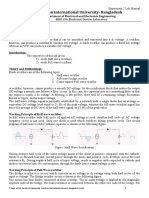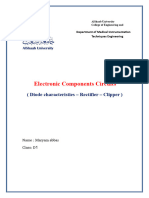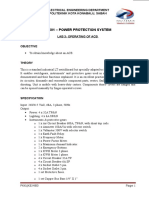LAB 2b
LAB 2b
Uploaded by
guntadiCopyright:
Available Formats
LAB 2b
LAB 2b
Uploaded by
guntadiOriginal Description:
Original Title
Copyright
Available Formats
Share this document
Did you find this document useful?
Is this content inappropriate?
Copyright:
Available Formats
LAB 2b
LAB 2b
Uploaded by
guntadiCopyright:
Available Formats
DEPARTMENT OF ELECTRICAL ENGINEERING LAB WORK ET502 POWER ELECTRONICS
EXPERIMENT : 2b TITLE : SINGLE PHASE HALF-WAVE AND FULL WAVE UNCONTROLLED RECTIFIER (Practical) OUTCOME :
Upon completion of this unit, student should be able to: i. Handle the practical work on the power electronics converters using appropriate equipment. [CLO3](PLO2,LD2,P3) OBJECTIVES : 1. Justify the results in Lab 2a 2. Describe the performances of these Rectifiers 3. Describe the differences of these Rectifiers COMPONENTS/EQUIPMENTS: 1. Diodes 1N4002 2. Resistor 1kohm 3. LED 4. AC Supply Unit 5. Oscilloscope 6. Digital Multimeter
BRIEF THEORY
One of the important applications of the P-N junction diodes is in converting alternating current (AC) into direct current (DC). Half-wave rectifiers can be used, but they are highly inefficient in converting AC power to DC power. Additionally they have high contents of harmonics, which are difficult to filter out and to smooth out the ripple in the rectified AC power. On the other hand, full-wave rectifier improves on the conversion efficiency of AC power to DC power. It will also reduce the harmonic contents of the rectified waveform and reduce the requirement on the smoothing filter needed to reduce the ripple in the rectified waveform. PART 1: Single Phase Half Wave Rectifier PROCEDURE : 1. Construct the circuit in Figure 1. 2. Set the AC Supply Unit with 12V and connect to the circuit. 3. Connect the probe of the oscilloscope to point A and point B. 4. Draw the waveform obtained. 5. Next, connect the diode in opposite direction. 6. Repeat Step 3 and 4. PART 2: Single Phase Full Wave Rectifier PROCEDURE : 1. Construct the circuit in Figure 1. 2. Set the AC Supply Unit with 12V and connect to the circuit. 3. Connect the probe of the oscilloscope to point A, point B and point C. 4. Draw the waveform obtained. 5. Measure the current at point D. (Remember to select DC range at your digital multimeter) 6. Next, connect the diode in opposite direction. 7. Repeat Step 3 to 5. Notes:
1. In the previous experiment, the value of your voltage was 17Vp where p = peak. 2. In this experiment, the value of your voltage from the AC Supply Unit is not in peak value, instead is in rms value. 3. Therefore the conversion of the Vp to Vrms can be done through Vrms = (Vp/2). RESULTS: As your result: print out: 1. Sketch the respective graphs complete with their labels indicating forward biased and reversed biased. 2. Complete the chart at the next page. 3. Discuss the results by comparing the simulation results and the practical results. Table 1: Results Single Phase Half Wave Rectifier Vin Vout Part 1: Point A Point B Single Phase Full Wave Rectifier
Figure 1: Single Phase Half Wave Rectifier
Part 2:
Point B
Point D
Point A
Point C
Figure 2: Single Phase Full Wave Rectifier
You might also like
- EPC BEC303 List of ExpsDocument51 pagesEPC BEC303 List of Expskaranphutane2254No ratings yet
- Principles of Power System (V.k. Mehta Rohit Mehta)Document1 pagePrinciples of Power System (V.k. Mehta Rohit Mehta)guntadi100% (2)
- v85NX, v100NX System DiagramDocument4 pagesv85NX, v100NX System DiagramIoannisNo ratings yet
- Experiment: Title: DC Power Supply Unit: Transformer ObjectiveDocument14 pagesExperiment: Title: DC Power Supply Unit: Transformer ObjectiveLian Ai Chen100% (1)
- Lab 2 - Diode CharacteristicsDocument7 pagesLab 2 - Diode CharacteristicsFasil EndalamawNo ratings yet
- Pemetaan DK NP NADocument37 pagesPemetaan DK NP NAguntadiNo ratings yet
- 722.9 ManualDocument60 pages722.9 ManualDenis Konovalov100% (2)
- Hitachi ZX85USB-6 Compact-Excavator KS-EN440EUDocument20 pagesHitachi ZX85USB-6 Compact-Excavator KS-EN440EUbudimir2310No ratings yet
- NCR Selfserv™: 22, 22E, 25, 26, 28, 31, 36 Atms Site Preparation RequirementsDocument32 pagesNCR Selfserv™: 22, 22E, 25, 26, 28, 31, 36 Atms Site Preparation Requirementsmss_vnr50% (2)
- DPU4F NewDocument21 pagesDPU4F NewDeepak GuptaNo ratings yet
- KAlam LabManual EEE102 EWU Summer 2012Document18 pagesKAlam LabManual EEE102 EWU Summer 2012Max TanNo ratings yet
- DEVICE EXP 2 Student - 2Document4 pagesDEVICE EXP 2 Student - 2Pablo ChanNo ratings yet
- Lab Report 2Document11 pagesLab Report 2Mike TNo ratings yet
- Clipper and Climper Circit PDFDocument6 pagesClipper and Climper Circit PDFOmar Said Abu RabieNo ratings yet
- Lab Manual Exp 8 - RectifierDocument7 pagesLab Manual Exp 8 - RectifierMohd Fazri SedanNo ratings yet
- EXPERIMENT 1 Diode Characteristic and Rectifier CircuitDocument12 pagesEXPERIMENT 1 Diode Characteristic and Rectifier CircuitJoshua DuffyNo ratings yet
- Device Exp 2 Student ManualDocument4 pagesDevice Exp 2 Student Manualgg ezNo ratings yet
- Student Workbook PDFDocument103 pagesStudent Workbook PDFCarbon Nano TubeNo ratings yet
- (ALCANTARA - BSEE-2D) Experiment 2 Final ReportDocument11 pages(ALCANTARA - BSEE-2D) Experiment 2 Final ReportLawrence Abram AlcantaraNo ratings yet
- Electrical Engineering LaboratoryDocument29 pagesElectrical Engineering Laboratorybrhanu degeneNo ratings yet
- Basic Electronics PracticalDocument9 pagesBasic Electronics Practicalasfadare100% (2)
- Lab#11 EEDocument16 pagesLab#11 EEJunaid KhalidNo ratings yet
- Lab2 Report 1620660042Document21 pagesLab2 Report 1620660042Nafiz SheikhNo ratings yet
- Diode Clippers and Clampers: ObjectiveDocument17 pagesDiode Clippers and Clampers: Objectiveashriii1154No ratings yet
- Half Wave Rectifier and Full Wave RectifierDocument5 pagesHalf Wave Rectifier and Full Wave RectifierAdvyth Vaman AkalankamNo ratings yet
- American International University-Bangladesh: Title: Ramp Control of A Single Phase Half Converter AbstractDocument3 pagesAmerican International University-Bangladesh: Title: Ramp Control of A Single Phase Half Converter AbstractCarry GamingNo ratings yet
- Exp. 1 ManualDocument4 pagesExp. 1 Manualf20212001No ratings yet
- Laboratory Experiment No. 1 ObjectivesDocument3 pagesLaboratory Experiment No. 1 ObjectivesyzlebalitaNo ratings yet
- ED Lab Experiment Manual 2Document6 pagesED Lab Experiment Manual 2mrcox17324No ratings yet
- Lab104 Rectifiers YaqeenAldubaisiDocument8 pagesLab104 Rectifiers YaqeenAldubaisiYaqeen AldubaisiNo ratings yet
- Experiment 3 Buck ConverterDocument8 pagesExperiment 3 Buck Converterprop_kcpNo ratings yet
- Half Wave Rectifier and Full Wave RectifierDocument4 pagesHalf Wave Rectifier and Full Wave Rectifierjosephmathewt98No ratings yet
- Lab 02Document5 pagesLab 02Muhammad Owais RazaNo ratings yet
- Electronic Circuits and Devices Laboratory - ELCE-221 Experiment No. 2 Diode Applications (Part A) Rectifiers, ClippersDocument6 pagesElectronic Circuits and Devices Laboratory - ELCE-221 Experiment No. 2 Diode Applications (Part A) Rectifiers, ClippersLittle VoiceNo ratings yet
- Electronics Circuit Design LabDocument34 pagesElectronics Circuit Design Labsrvdhar100% (1)
- Full Wave Bridge Rectifier: Experiment No. 6Document5 pagesFull Wave Bridge Rectifier: Experiment No. 6Mohsin Iqbal Department of Electrical EngineeringNo ratings yet
- EDC Lab ManualDocument48 pagesEDC Lab ManualDishan D Shah100% (1)
- Centre Tapped Full WaveDocument7 pagesCentre Tapped Full WaveRashid Rind Rashid Rind100% (1)
- Single Phase Full Wave Voltage Multiplier PDFDocument3 pagesSingle Phase Full Wave Voltage Multiplier PDFJoshua Amiel javines0% (1)
- Lab 4 Half Wave and Full WaveDocument8 pagesLab 4 Half Wave and Full WaveRashid Rind Rashid Rind100% (1)
- Experiment 1Document2 pagesExperiment 1MeghaNo ratings yet
- ED REPORT (GRP 3)Document9 pagesED REPORT (GRP 3)Shreyas MarudwarNo ratings yet
- Electronics Devices Lab - Exp 2 - Mid Term - Fall 22-23 - ACSDocument19 pagesElectronics Devices Lab - Exp 2 - Mid Term - Fall 22-23 - ACSdark lionNo ratings yet
- 1EE 415 Lab # 3Document4 pages1EE 415 Lab # 3Ricky TerryNo ratings yet
- Physics Lab - Rectification and Smoothing of An A.C. VoltageDocument8 pagesPhysics Lab - Rectification and Smoothing of An A.C. Voltageaben50% (2)
- Electronics Device Circuit Lab SheetDocument27 pagesElectronics Device Circuit Lab Sheetjimfinch512No ratings yet
- Experiment 4Document10 pagesExperiment 4djelbouNo ratings yet
- EE1 Lab5 6 ACcircuit v2 Sept22Document7 pagesEE1 Lab5 6 ACcircuit v2 Sept22Lê Nguyễn Nguyên ThiêngNo ratings yet
- Electronic Components Circuits: (Diode Characteristies - Rectifier - Clipper)Document14 pagesElectronic Components Circuits: (Diode Characteristies - Rectifier - Clipper)em2200139No ratings yet
- Eee 3204Document22 pagesEee 3204Sarwar Hosen SimonNo ratings yet
- Group 5 - Laboratory No. 5Document14 pagesGroup 5 - Laboratory No. 5Angel GonzalesNo ratings yet
- Experiment 2 Wave Shaping CircuitsDocument9 pagesExperiment 2 Wave Shaping CircuitsMaria Abia Lapena50% (2)
- NRI Discovery LabDocument19 pagesNRI Discovery Labden headNo ratings yet
- EEE 111 Lab Manual 2Document6 pagesEEE 111 Lab Manual 2SHADOW manNo ratings yet
- Lab 2 - Clampers N ClippersDocument5 pagesLab 2 - Clampers N ClippersDaus VillaNo ratings yet
- Lab2 DiodesDocument5 pagesLab2 DiodeschilloutbrahNo ratings yet
- Lab Manual 3 Semester Basic Electronics - I: Lab Engineerer: Subject TeacherDocument21 pagesLab Manual 3 Semester Basic Electronics - I: Lab Engineerer: Subject TeacherOmer Sheikh100% (1)
- Full Wave Centre Tapped Rectifier: Experiment No. 5Document4 pagesFull Wave Centre Tapped Rectifier: Experiment No. 5Mohsin Iqbal Department of Electrical EngineeringNo ratings yet
- Power Electronics ManualDocument42 pagesPower Electronics ManualJavaria Chiragh50% (2)
- Lab Handouts # 3Document6 pagesLab Handouts # 3Kashif Mujeeb Abdul MujeebNo ratings yet
- EPD Lab#9Document8 pagesEPD Lab#9Muhammad ShaheerNo ratings yet
- Lab 8 Report Electronics 1Document13 pagesLab 8 Report Electronics 1Dawn J. OwensNo ratings yet
- EE331 Lab 1 v2Document13 pagesEE331 Lab 1 v2Áo ĐenNo ratings yet
- ECA ManualDocument50 pagesECA ManualkrajenderreddyNo ratings yet
- Design of Electrical Circuits using Engineering Software ToolsFrom EverandDesign of Electrical Circuits using Engineering Software ToolsNo ratings yet
- Reference Guide To Useful Electronic Circuits And Circuit Design Techniques - Part 1From EverandReference Guide To Useful Electronic Circuits And Circuit Design Techniques - Part 1Rating: 2.5 out of 5 stars2.5/5 (3)
- Lab 3Document6 pagesLab 3guntadiNo ratings yet
- Air Conditioning Technology: Basic Refrigeration Components and CycleDocument154 pagesAir Conditioning Technology: Basic Refrigeration Components and CycleguntadiNo ratings yet
- List of Branches Closed-24 March 2020 - v3Document10 pagesList of Branches Closed-24 March 2020 - v3guntadiNo ratings yet
- 1 Transmission OverviewDocument9 pages1 Transmission OverviewguntadiNo ratings yet
- LAB 2aDocument5 pagesLAB 2aguntadiNo ratings yet
- Kursus Fabrikasi Projek 1: 21 - 25 Mei 2012 Makmal Projek JkeDocument19 pagesKursus Fabrikasi Projek 1: 21 - 25 Mei 2012 Makmal Projek JkeguntadiNo ratings yet
- Protective RelayingDocument4 pagesProtective RelayingguntadiNo ratings yet
- Instruction Description Operation Flag CLK Data Transfer InstructionsDocument1 pageInstruction Description Operation Flag CLK Data Transfer InstructionsguntadiNo ratings yet
- LAB 1b PracticalDocument4 pagesLAB 1b PracticalguntadiNo ratings yet
- Test 1Document3 pagesTest 1guntadiNo ratings yet
- Fourier SeriesDocument7 pagesFourier Seriesguntadi100% (2)
- Over Current ProtectionDocument40 pagesOver Current ProtectionguntadiNo ratings yet
- Test 1Document2 pagesTest 1guntadiNo ratings yet
- WECC Current Transformer GuideDocument49 pagesWECC Current Transformer GuideguntadiNo ratings yet
- Basic of Protection SystemsDocument36 pagesBasic of Protection SystemsguntadiNo ratings yet
- Chapter 1: Introduction To Control System: Kolej Universiti Teknikal Kebangsaan MalaysiaDocument5 pagesChapter 1: Introduction To Control System: Kolej Universiti Teknikal Kebangsaan MalaysiaguntadiNo ratings yet
- Ducato 290 Handbook 05-15 PDFDocument387 pagesDucato 290 Handbook 05-15 PDFDaniNo ratings yet
- List of Outside Recognized Laboratories: SL No. Name of The Recognized Laboratory Lab Code Testing Charges RemarksDocument18 pagesList of Outside Recognized Laboratories: SL No. Name of The Recognized Laboratory Lab Code Testing Charges RemarksGokul KrishnanNo ratings yet
- Strahman SamplingValvesDocument19 pagesStrahman SamplingValvesAnupkumar ParikhNo ratings yet
- Hilomast BalunDocument30 pagesHilomast BalunOnur BayınNo ratings yet
- GAD-based C Cebu: ModelDocument20 pagesGAD-based C Cebu: ModelDell Nebril SalaNo ratings yet
- LPB040 Installation Guide (B - 2040139 - 1 - 5) - 1Document14 pagesLPB040 Installation Guide (B - 2040139 - 1 - 5) - 1Fabian CruzNo ratings yet
- E6 UNIT-2 ĐỀ-1Document3 pagesE6 UNIT-2 ĐỀ-1Anh Bùi Thị ViệtNo ratings yet
- Electronic Speed Controls: Theory of OperationDocument17 pagesElectronic Speed Controls: Theory of OperationChristian BedoyaNo ratings yet
- Baba AutomobileDocument54 pagesBaba AutomobilerupeshNo ratings yet
- Drill TechniquesDocument5 pagesDrill TechniquesJoaquín Capella CallavedNo ratings yet
- Siemens SiriusDocument52 pagesSiemens SiriusConsul TechNo ratings yet
- Ethernet Communication ModuleDocument11 pagesEthernet Communication Modulemuneeb.irfan9873No ratings yet
- Pumping For WaterDocument17 pagesPumping For WaterJeffrey CaparasNo ratings yet
- BOSCH-REXROTH - RE18302-09 - VS241-245-246-247 F - NloDocument10 pagesBOSCH-REXROTH - RE18302-09 - VS241-245-246-247 F - Nloaron.maticNo ratings yet
- A Project On Electric CarsDocument11 pagesA Project On Electric CarsKARAN UPADHAYAYNo ratings yet
- John Deere 853a Row Crop Head Parts CatalogDocument10 pagesJohn Deere 853a Row Crop Head Parts Catalogann100% (54)
- Product Range Alfa LavalDocument13 pagesProduct Range Alfa LavalSoficu Daniel100% (1)
- Power Tools - MAGPRIME CORP. 05-2024.Document1 pagePower Tools - MAGPRIME CORP. 05-2024.AWTSS SooNo ratings yet
- ABB Motors and Technical Data Sheet Generators: No. Data Unit RemarksDocument5 pagesABB Motors and Technical Data Sheet Generators: No. Data Unit RemarksRishi TandonNo ratings yet
- Power Transistor Array STA463C: Absolute Maximum Ratings Electrical Characteristics External DimensionsDocument1 pagePower Transistor Array STA463C: Absolute Maximum Ratings Electrical Characteristics External DimensionsAntony TorrezNo ratings yet
- Asynchronous GeneratorDocument16 pagesAsynchronous GeneratorsalmanassriNo ratings yet
- Chapter 1 - PLC OverviewDocument55 pagesChapter 1 - PLC Overviewbob100% (2)
- LNS125 ValveDocument1 pageLNS125 ValvesahawaeNo ratings yet
- Instruction Manual: A979 1:18 4WD Monster Truck RC CarDocument6 pagesInstruction Manual: A979 1:18 4WD Monster Truck RC CarkellyNo ratings yet
- InternshipDocument22 pagesInternshipRahul KumarNo ratings yet











































































































